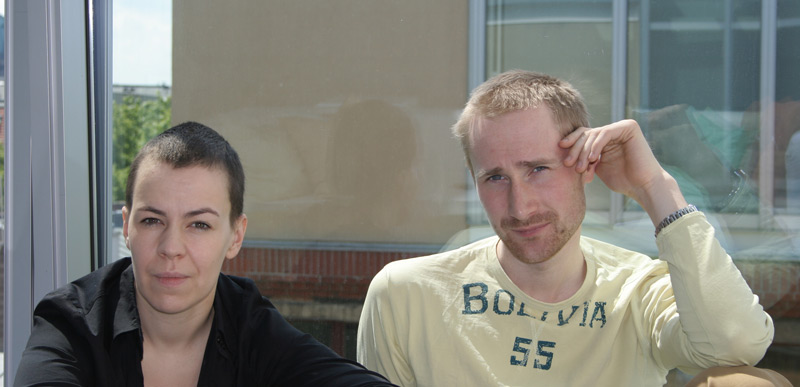about the production
What do we need art for? Do we today need theatre? Does art give us answers to important questions? Does it actually touch our lives? Can artists speak about what we are interested in and what we live today in an original language?
Similar questions are brought in the production of a young ensemble of theTallin N099 Theatre. They are straight and daring, not an empty provocation. “Tiit Ojasoo’s affirmation that the specific person and name of the present Minister of Culture is not particularly important in the stage production probably sounds insincere to many. There is broader subject matter dealt with on stage ... relying solely on name-based puns would be somewhat “uncultured”. Associations which appear are right in the beginnings of the production denied by the character of Beuys himself. His inquisitive attitude behind his overshadowed facial expressions is directed straight into the audience, inferring that the one he is about to start explaining art to from the stage is not a rabbit, and certainly not Minister Jänes, but the entire audience, who is his Guinea pig.
The production is accompanied by the spirit of German conceptual artist Joseph Beuys – but without macabre and simulated piety. Director Tiit Ojasoo is very well aware of the difference between the confrontation of an artist with a recipient and criticism of society in the avant-garde period in the 1960s and today´s globalized world. Nevertheless, the basic impulse which motivates an artist to action has been the same for decades: is art only an amusement of “bourgeois” society or can it have a political influence on society?
Estonian creators have no problem or bashfulness to speak about unsolvable problems and repeat the hundred times said – instead of sobbing in pubs, idle talks in cafés, anonymous discussion forums or populist TV debates, they go and sell themselves. They are honest in what they do, and hand in hand with the criticism of society goes the criticism of their own circles. That is why the spectators are frozen when watching young people for whom art is the meaning of life; they are furious with rage when hearing never-ending speeches of state power representatives saying that only those nations and countries are to survive whose culture is alive; they want to analyze and debate when seeing dozens of beautiful associations, artistic images as well as unashamed stereotypes; they laugh heartily when comparing the immeasurable values of culture and measurable values of sport achievements... All in all, they are not ignorant to it. And moreover, they have fun.
The journey through the spectre of unbound comical scenes, absurd acts, unpretentious and quite real confessions and bitter confrontations can be in the current state of our theatre-making very inspiring – the connection of Slovakia and Estonia in this case is not coincidental: “The role of the artist and of the arts has rapidly changed in Estonia. During Soviet times Estonian artists and intellectuals were national lighthouses, whose impact on society´s values was remarkable. Today one can see clearly that their position has lost its importance as art-hating populist voices gather popularity.”
Romana Maliti
Using NO99 materials and reviews by Madis Kolk “Brutalization or Reconciliation?”
creators
directed by Tiit Ojasoo, Ene-Liis Semper
idea, production, set design and costumes: Tiit Ojasoo, Ene-Liis Semper
dance scene: Mart Kangro
texts: Eero Epner
sound installation mix: Hendrik Kaljujärv
video lecture: Eha Komissarov
performers: Tiit Ojasoo, Ene-Liis Semper, Rasmus Kaljujärv, Risto Kübar, Andres Mähar, Mirtel Pohla, Jaak Prints, Gert Raudsep, Inga Salurand, Tambet Tuisk, Marika Vaarik, Sergo Vares
director

Tiit Ojasoo (1977) graduated from the Estonian Academy of Music and Theatre Drama School in 2000. After graduating he worked at the Estonian Drama Theatre as a director. In 2004 he worked as an artistic director of the Vanalinnastuudio Theatre, which was later renamed as NO99. Gradually, at various Estonian theatres he directed plays by Shakespeare, Bernard Maria Koltès, Akira Kurosawa, Martin McDonagh, Alfred Jarry, he also worked with texts by Yukio Mishima and Sarah Kane. He also wrote his own texts or the text is a result of the collaboration between Ojasoo and his artistic team (Oil!, GEP, How to Explain Pictures to a Dead Hare). The international jury of the DRAAMA Theatre Festival selected Ojasoo twice as Best Director (for Juliet in 2005 and for GEP in 2007). In 2006, Ojasoo was awarded the Ants Lauter Prize for his remarkable productions staged after his graduation. His Roberto Zucco and GEP won prizes at the Torun Theatre Festival. Tiit Ojasoo directed also a number of musicals and a rock opera entitled Ruja (Best Production in 2009). His productions were presented at many international festivals in Vienna, Cologne, Moscow, Tampere, Torun, Utrecht, St. Petersburg, Bern, Oldenburg, Berlin etc. Within the OFF Programme at the Divadelná Nitra festival 2005 he directed the staged reading of the text by Jan Ritsema and Bojana Cvejić – Papelines, a Construction.
Ene-Liis Semper (1969) graduated from the Estonian Academy of Arts in 1995 where she studied stage design. She has made almost hundred set and costume designs in different Estonian theatres and opera houses. In some productions she participated as a co-director and scriptwriter. Four times, she won Best Stage Designer plus Best Director (Juliet) and Best Production (Ruja) – both with Tiit Ojasoo and various prizes for her video works. They were presented at many international exhibitions, including the Venice Biennale.
Materials available
Script of the production: EN, EE
If you are interested in these materials, write to archivy@nitrafest.sk
